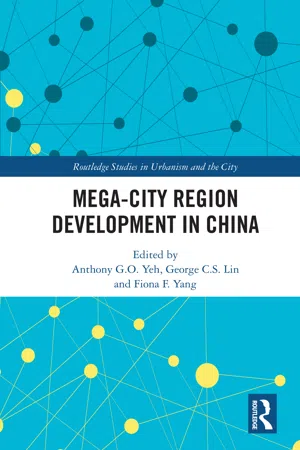1 Introduction and overview
Emerging mega-city regions in China
Anthony G.O. Yeh, George C.S. Lin and Fiona F. Yang
Introduction
As a type of regional spatial formation under large-scale urbanization and urban sprawl, a mega-city region represents a cluster of cities which are administratively separate but intensively networked, and clustered around one or more larger central cities (Hall and Pain 2006). In the Western countries, mega-city regions have evolved through the pathways of “cities – city regions – mega-city regions”. While being extensively examined in the Western context, mega-city regions have also emerged in the rapidly urbanizing global south countries (e.g., Mexico, Indonesia and China). Some of mega-city regions in the global south are anchored by at least one mega city1 which has at least 10 million inhabitants. Located in various parts of the world, these regions are evolving in diverse institutional and economic contexts, despite all undergoing rapid transformation in an era of globalization.
While mega-city regions and the spatial clustering of cities have been extensively discussed in the Western literature (e.g., Gottmann 1961; McGee 1991; Scott 2001; Hall and Pain 2006), they have recently been put at the forefront of policy debates in China due to their increasing important position in China’s urbanization and economic development. The economic reform since 1978 has led to an unprecedented growth in the history of population and economic development (Yeh et al. 2015), while a large part of the increased urban population and the corresponding economic growth has been concentrated in the mega-city regions, such as Beijing-Tianjin-Hebei region (BTH), Yangtze River Delta (YRD) and Pearl River Delta (PRD).2 In the past two decades, these regions have undergone profound transformation. Many cities and towns that were formerly peripheral or rural areas have developed into economic centers. It is evident that the three largest mega-city regions in China accounted for only 5.0% of the land area, but possessed 24.1% of the population and 38.6% of the GDP of the national total in 2018 (China State Statistical Bureau 2019; Statistical Bureau of Guangdong Province and Survey Office of the National Bureau of Statistics in Guangdong 2019). The important position of mega-city regions in China’s economic development has been recognized in the country’s socioeconomic development strategies in the recent decades. In the 13th Five-year Plan (2016–2020)3, 19 mega-city regions have been explicitly identified as national engines of urbanization and economic growth. In parallel with the national strategies, local (e.g., provincial and prefectural) governments have been taking active roles in developing mega-city regions in order to gain competitive advantage.
In this context, a careful examination of the development trajectory of China’s mega-city regions and resultant challenges is needed in order to support their future development. As China has adopted a gradual mode of economic reform that is different from both market-dominated Western economies and former socialist countries using an aggressive model of transition, which has led to “multiple and simultaneous economic, social, and spatial restructuring” (Ma and Wu 2005), the development of mega-city regions in China has undergone a quite distinct pathway compared with most Western countries. Consecutive waves of urbanization and economic transition since 1978, such as rural industrialization in the early stage, land-centered development and recent urban tertiarization, have imposed profound impact on the territory development at various scales. It remains to be explored whether the concept and definition of mega-city regions in China are comparable with that in the Western countries. Although China has to a certain extent managed to promote economic growth and avoid many urban problems that commonly occurred in Western countries (e.g., inner-city decay) and other developing countries (e.g., slums and hawkers), a number of “distinctive” challenges have been witnessed from the development of mega-city regions in China, such as jurisdictional fragmentation, poor housing and services in suburban townships, hukou-based social exclusion for immigrants and environmental degradation. With a development trajectory different from their Western counterparts, it is also questionable to what extent Western literature can give useful insights on the patterns and challenges of mega-city regions in China.
This book attempts to explore the across-the-board questions related to the development of mega-city regions in China. The central aim is to clarify various concepts of mega-city regions in China when existing literatures mainly focus on Western cases that are different from the Chinese context, and to unravel the unique dynamics and challenges of mega-city region development in China from various perspectives so that appropriate strategies can be formulated to facilitate the future planning and governance of China’s mega-city regions. This book hopes to provide insights for the understanding of mega-city region development in China in order to open up new avenues for further research and international comparative study.
Concepts and typology of mega-city regions
In the Western countries, mega-city regions have evolved through the pathways of “cities – city regions – mega-city regions” (Figure 1.1). The massive suburbanization in the post-war period of the 20th century has linked cities and suburbs that were jurisdictionally separate and thus fostered numerous city regions (a.k.a. metropolitan areas or functional urban regions). Such urban development ac...
